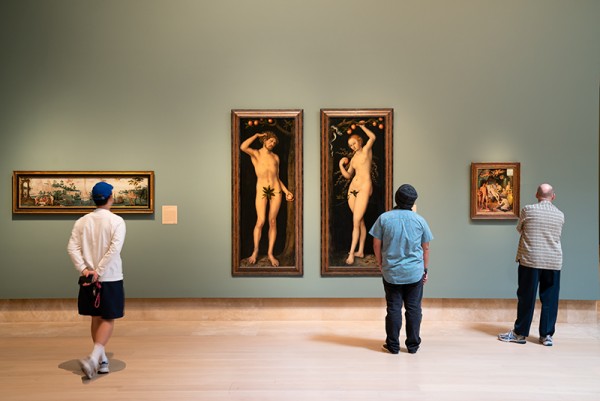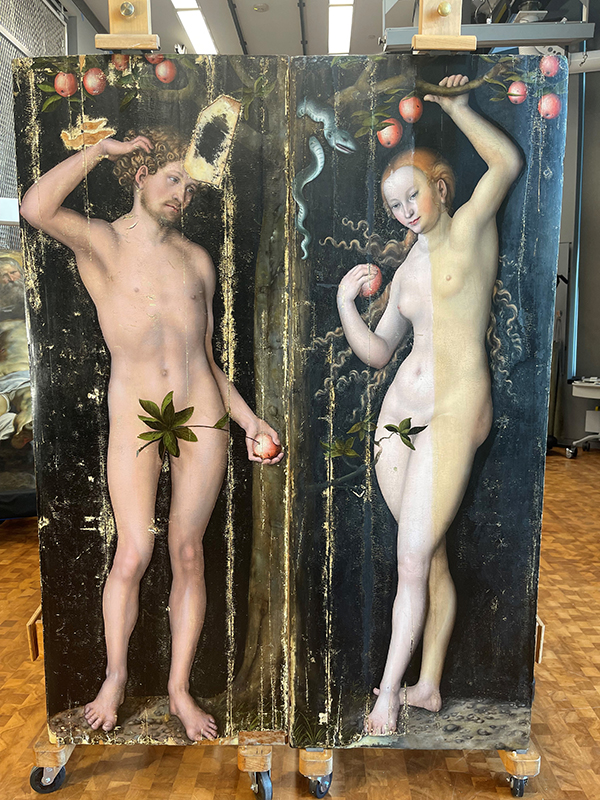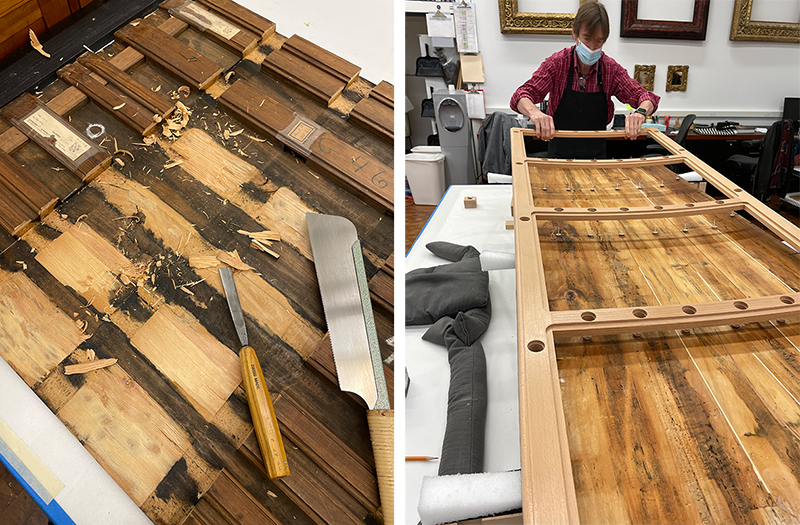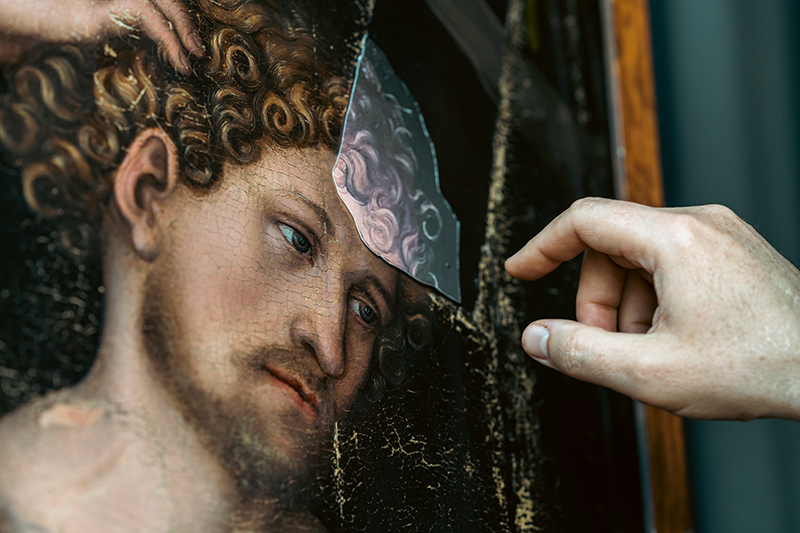Conserving Lucas Cranach’s Adam and Eve

Lucas Cranach the Elder (German, 1472–1553), Adam and Eve, c. 1530, oil on panel (pair), Norton Simon Art Foundation, on view in the Museums galleries in 2019, photo by Elon Schoenholz
Lucas Cranach the Elder’s nearly life-size paintings of Adam and Eve (c. 1530) are among the Norton Simon Museum’s best known and most captivating works from this period. Painted when Cranach was serving as court painter to the Electors of Saxony in Wittenberg, the Museum’s pendants are one of at least 18 versions of the temptation of Adam and Eve that the artist and his workshop produced, transforming a composition inspired by Albrecht Dürer’s famous engravings into highly accomplished and provocative paintings.
As with many 16th-century paintings made on wooden panels, Cranach’s Adam and Eve were subjected to the common 19th-century practice of “cradling”—the panels were planed down and backed by a grid of wooden slats mounted to the back of the support—at some point before their discovery in a church in Kiev in 1919. This intricate structure was intended to allow natural expansion and contraction of the wood while preserving a flat surface. Unfortunately, cradling systems often cause more damage than they prevent. Forcing the panels to remain flat while expanding and contracting due to fluctuations in the environment concentrates stress at regular intervals across the surface, eventually splitting the wood and resulting in what has been termed a “washboard” effect.
As part of a Conservation Partnership with the Department of Paintings Conservation at the J. Paul Getty Museum, the Norton Simon Museum has undertaken a two-year project to repair the structural support and restore the surface appearance of Adam and Eve. For this multiphase undertaking, we are working with Ulrich Birkmaier, Senior Conservator in the Getty’s Paintings Conservation Department, and two experts who specialize in large-scale wooden supports: George Bisacca, Conservator Emeritus at the Metropolitan Museum of Art; and José de la Fuente, Conservator of Panel Paintings at the Museo del Prado in Madrid.


During the summer and early fall of 2021, Birkmaier conducted a thorough cleaning of the surface of each panel, removing the varnish and campaigns of old retouching and fills. Next, Bisacca and De la Fuente initiated the complex process of removing the cradle from each panel and attaching a new support system of their own design. After surgically detaching the cradles, they painstakingly filled every one of the minute cracks in the seven discrete planks of wood that comprise each of the panels, then fitted all crevices with perfectly shaped wedges using wood of the same density as that used by Cranach. This process reestablished consistent strength and a gentle natural curvature in each panel.
A large wooden insert near Adam’s forehead—probably dating to the time of the panel’s construction and intended to eliminate a knot or other flaw in the wood—posed particular challenges to the process. Inserted at an oblique angle relative to the overall grain direction, the insert had been the site of repeated repair, paint loss and restoration, at one point being completely surfaced with a wax putty and repainted. Bisacca and De la Fuente created a new insert for this area by laminating together correctly oriented pieces of antique linden wood and shaping them to match the curvature of the panel. The final stage of their work involved creating a new support system to replace the cradles. For this, Bisacca and De la Fuente designed a highly specialized strainer—a framework constructed to match the nuanced curvature of the panels and secured to an adjustable spring system. This innovation enables the strainer to respond to infinitesimal movements in the wood while providing physical support.

With this structural work complete, Birkmaier has now turned to the time-consuming process of filling losses and retouching to ensure that the appearance of the panels adheres more closely to Cranach’s original design. To address the area of loss in and around Adam’s forehead, Birkmaier looked to similar versions of Adam by Cranach to re-create a hairline more in keeping with the artist’s style. An area of degradation affecting Eve’s toes, probably resulting from water damage at an earlier stage in the painting’s history, also required some inpainting to return them to their proper shape and appearance. With the application of an appropriate varnish, the delicacy and sensuousness of Cranach’s painting technique now stands forward, revealing a subject as beguiling to contemporary viewers as it was in Cranach’s lifetime.
With the reestablishment of the gentle curvature of the panels, the paintings no longer fit into their previous frames. We took this opportunity to commission new frames for the pair that are inspired by Northern European designs of this era. We anticipate debuting Adam and Eve in their newly resplendent conditions, first at the Getty Center, where they will be on view January 23–April 21, 2024, followed by the Norton Simon Museum in May. We are grateful to our esteemed colleagues for their exceptional work on this project and look forward to sharing the magnificent results of this treatment with our members and visitors soon.
—Emily Talbot, Chief Curator, and John Griswold, Conservator
This article first appeared in the Museum’s Summer 2023 Newsletter.
Conservation photos by Emily Talbot; George Bisacca; and Cassia Davis, © J Paul Getty Trust 2023
